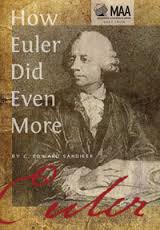The first chapter in the book is about the Euler line which is:
a line determined from any triangle that is not equilateral. It is a central line of the triangle, and it passes through several important points determined from the triangle, including the orthocenter, the circumcentre, the centroid, the Exeter point and the centre of the nine-point circle of the triangle. From Wikipedia.
 |
Euler's line (red) is a straight line through the centroid (orange), orthocentre (blue), circumcentre (green) and centre of the nine-point circle (red).
|
A hundred years ago, if you’d asked people why Leonhard Euler was famous, those who had an answer would very likely have mentioned his discovery of the Euler line, the remarkable property that the orthocenter, the centre of gravity and the circumcenter of a triangle are collinear. But times change, and so do fashions and the standards by which we interpret history.
At the end of the 19th century, triangle geometry was regarded as one of the crowning achievements of mathematics, and the Euler line was one of its finest jewels. Mathematicians who neglected triangle geometry to study exotic new fields like logic, abstract algebra or topology were taking brave risks to their professional careers. Now it would be the aspiring triangle geometer taking the risks.
Euler seems to have been more interested in reconstructing the triangle from the various centres than in the fact that these centres were collinear. Sandifer compares Euler to Columbus in the conclusion to the chapter:
In some ways, Euler’s discovery of the Euler line is analogous to Columbus’s “discovery” of America. Both made their discoveries while looking for something else. Columbus was trying to find China. Euler was trying to find a way to reconstruct a triangle, given the locations of some of its various centres. Neither named his discovery. Columbus never called it “America” and Euler never called it “the Euler line.”
Both misunderstood the importance of their discoveries. Columbus believed he had made a great and wonderful discovery, but he thought he’d discovered a better route from Europe to the Far East. Euler knew what he’d discovered, but didn’t realise how important it would turn out to be.
Finally, Columbus made several more trips to the New World, but Euler, as with his polyhedral formula and the Königsberg bridge problem, made an important discovery but never went back to study it further.The Wikipedia article makes the important point that the incentre does not normally lie on the Euler line, except in the case of an isosceles triangle. In the case of an equilateral triangle, there is no line because all the points are coincident. An interesting point is that there is an equivalent Euler line for the quadrilateral and tetrahedron. There are also other points that lie on the Euler line. These are:
A comprehensive biography of Euler can be found here on the MacTutor site where the biographies of many other mathematicians can be found. To quote from this site: Euler was the most prolific writer of mathematics of all time and we owe to Euler the notation $f(x)$ for a function (1734), $e$ for the base of natural logs (1727), $i$ for $\sqrt{-1}$ (1777), $\pi$ for pi, $\Sigma$ for summation (1755), the notation for finite differences $\Delta y$ and $\Delta^2 y$ and many others.
